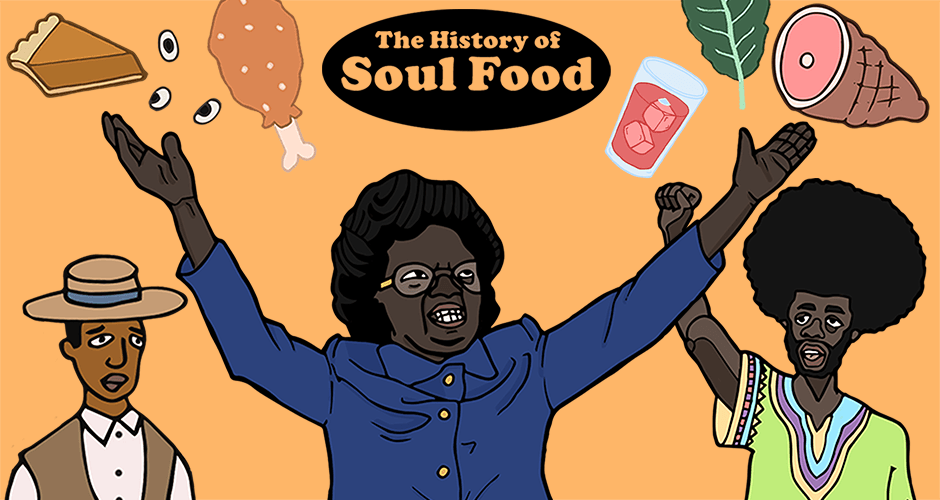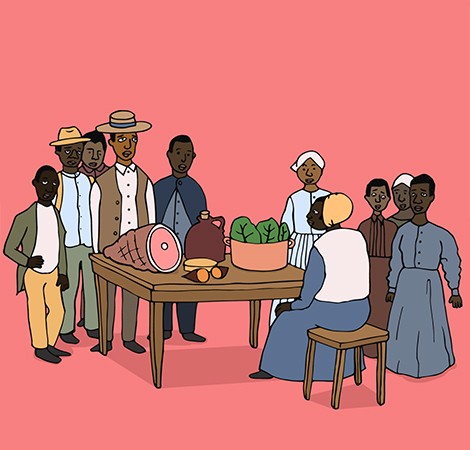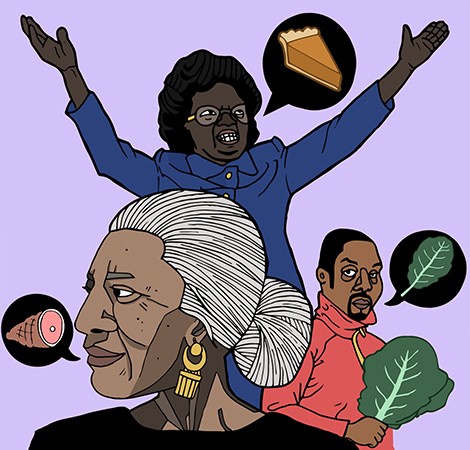James Beard Award-winning author and noted soul-food scholar Adrian Miller unpacks the complex origins of a cuisine rooted in both triumph and anguish.
Adrian “The Soul Food Scholar” Miller, is the author of the 2014 James Beard Foundation Award-winning book Soul Food: The Surprising Story of an American Cuisine, One Plate at a Time.
Soul food is a coined term that brilliantly captures the humanity and heroic effort of African-Americans to overcome centuries of oppression and create a cuisine that deliciously melds the foods and cooking techniques of West Africa, Western Europe, and the Americas. Simmering beneath this triumphant history is a complicated mixture of endearing and polarizing perspectives. The mention of the words soul food conjures up glorious stuff—fried chicken, smothered pork chops, coconut cake, peach cobbler, and red drink—as well as hard-times foods—like greens with salt pork, or ham hocks, black-eyed peas, and cornbread—that has sustained generations. For many, these dishes celebrate a heritage of culinary genius, community-building, and resourcefulness. Yet there are some who reach the opposite conclusion and criticize soul food as an incredibly unhealthy cuisine that needs a warning label, or as slave food that is unworthy of celebration.
Through this illustrated history, I’ll help explain how soul food became such a lightning rod in our culture. To do so, we’ll follow the same advice that I got from Lolis Elie, former Times Picayune columnist, culinary historian, and story editor on HBO’s Treme: “Follow the people.” How does a familiar cuisine changes when people take it to a foreign place and watch it evolve over time?
We pick up the story in the antebellum American South where millions of West Africans, forcibly removed from the home countries and enslaved, created one of America’s earliest fusion cuisines under difficult circumstances. Then, we explore what happens to soul food after the Civil War, during with the Great Migration, and through the turbulent 1960s, ending with a snapshot of today’s prevailing trends. By the conclusion, we’ll see that it’s no longer our grandmother’s soul food—or is it?
THE BIRTH OF A NEW CUISINE IN ANTEBELLUM AMERICA (1619-1865)
In the American South, as well as in the North, slave owners controlled the amount of food that enslaved African-Americans received. Generally, on a designated day of the week, each slave was allotted five pounds of a starch (cornmeal, rice or sweet potatoes); a couple of pounds of dried, salted, or smoked meat (beef, fish or pork—whatever was cheapest); and a jug of molasses. That’s it. So, the enslaved had to figure out ways to supplement their diet by fishing, foraging, hunting, gardening (some transplanted vegetables from Africa like okra), and raising livestock with farming knowledge passed down from West Africa, and new knowledge shared by their European slavers, neighboring poor whites, and indigenous people of the area. On the small farms and in cities, master and slave ate out of the same pot, but at different tables. On the large plantations, separate crews were formed to cook and feed the master’s family in the Big House and the field slaves.
On a typical day, the field slaves rose to eat a breakfast of buttermilk and crumbled cornbread mixed up and poured into a trough, a noontime “dinner” of boiled vegetables with some meat to flavor it and some red pepper for seasoning, and then a late-evening supper of leftover dinner portions and cold cornbread. Only on weekends when the work schedule slowed did the enslaved get access to prestige ingredients and foods involving the use of processed flour and refined sugar. This mix of prestige and poverty food set the tone for what we think of soul food today, but it was missing one ingredient—the freedom to choose what one ate. That came after Emancipation.
THE RECONSTRUCTION ERA: SUMPTUOUS CHURCH SUPPERS AND STARVING SHARECROPPERS (1865-1910)
The rise of the sharecropping system and the Black Church greatly affected the development of what we now call soul food. In the rural South, the very best food was showcased at Emancipation celebrations, holiday events, and black church gatherings. Of these, church gatherings were the most frequent and vital to the community, and they served celebratory foods like fried chicken, fried fish, cakes, sweet potato pies, red drinks, and watermelon. For the rest of the week, rural blacks consumed a diet similar to what they had during slavery—heavy on seasonal vegetables, very little meat, and variations of cornbread and water with increasing amounts of processed food.
If the black church symbolized some of the best of the rural South, the sharecropping system represented the worst. The former plantation masters, now called “landlords,” divided up their land into smaller plots for individual farmers (called “tenants” or “sharecroppers”). Generally, the tenants agreed to farm the land and give half the harvest proceeds to their landlord. The poor tenants had to borrow against their future proceeds just to get the basic supplies and equipment needed to farm. The tenants started off in debt, and the landlords did their best to keep them there. In time, sharecroppers had more incentive to use every inch of their land to grow the commodity crop rather than gardening their own food. Thus, they borrowed further against their advance to get groceries, with increasing amounts of processed food, at a nearby commissary run by the landlord. The decades after the Civil War continued the pre-slavery pattern of poverty food during the week and special occasion food on the weekends with church social functions. This pattern began to change when African-Americans were on the move again to “The Promised Land,” which for millions of people was anywhere but the South.
THE GREAT MIGRATION EXPANDS AFRICAN-AMERICAN CUISINE (1910s-1970s)
After years of spiraling debt and unbearable racism and oppression, millions of Southern blacks decided that the best solution was to simply leave. This massive movement of people, dubbed “The Great Migration,” happened in waves over the course of roughly seven decades (1910s to 1970s). Just like any other immigrant group arriving in a new place, the people who moved tried to recreate home and build community, and food was a critical factor to achieving both. Once these migrants prospered, they ate more prestige foods from the “old country” during the week rather than saving such dishes for special occasions.
Cities were often overwhelmed with the surge of black migrants, and they settled into crowded apartment buildings with very meager cooking facilities. These conditions made home-cooking a challenge, and fortunately relief organizations, restaurants, street vendors, and urban black churches were there to meet the needs of a hungry public. Because everyone who wasn’t Anglo-Saxon white was forced to live in close proximity in segregated sections of town, African-Americans encountered global immigrants and were early adopters of Chinese (chop suey, pork fried rice), Italian (macaroni, pizza, spaghetti), and Tex-Mex (chili, enchiladas) far before the mainstream public.
After World War II, the economic fortunes of African-Americans brightened, and some transitioned to homes with more yard space to garden, kitchens furnished with the latest appliances, and more disposable income to buy groceries. This growing prosperity incubated an enduring culinary tradition—Sunday dinner with extended family, with a table full of special-occasion foods.
SOUL FOOD GETS A SIDE OF BLACK POWER POLITICS (1960s-1990s)
The term soul food was seared in our nation’s consciousness during the 1960s even though it was bandied about through black culture since the 1940s. The 1960s were a time of strong expressions of black cultural identity, and economic and political power. Almost as instantaneously as soul food entered the mainstream, its meaning began to splinter. Many recognized its culinary, cultural, and marketing appeal and simply thought of it as a new label for the very best home-cooking passed down to them through the generations. Black power advocates seeking to unify African Americans across class, geography, and varying experiences with oppression saw cultural totems like food as a powerful connector. For them, soul food was cast as something that Southern whites, despite the shared culinary heritage, couldn’t understand. Others drawing from the same cultural source material argued that true soul food wasn’t the “master’s chicken-and-pork laden leftovers,” but a return to the traditional fish and vegetables diet of their ancestors, featuring West African ingredients like okra, black-eyed peas, tropical yams, millet, and sorghum.
We’re still living with the legacy of the purposeful rupture from Southern cuisine, where “soul” has come to equal “black,” and “Southern” equals “white.” By making soul food wholly black-owned, the African-American contributions to Southern cuisine have, unfortunately, been obscured. Yet, the dirty little secret of both soul food and Southern food is that, for the most part, black and white Southerners of the same socio-economic class are essentially eating the same foods.
SOUL FOOD AT A CROSSROADS (1990S- PRESENT)
Today, soul food is a many-splendored thing. First, there is the mother cuisine Southern food, which, in its pure form, is tied to the region and emphasizes seasonal vegetables and heritage animals prepared with traditional technique, while also mixing the high and the low. The late Edna Lewis was an eloquent advocate for this type of African-American cooking. Soul food, in its most popular and recognizable form, comes to us thanks to entrepreneurs like Harlem restaurateur Sylvia Woods and a multitude of home cooks, who transplanted and altered Southern cuisine in a way that allowed it to survive outside of the American South. This was largely achieved by using a mix of canned, dried, fresh, frozen, and packaged ingredients.
From that bedrock sprung “down home healthy” cuisine, which takes traditional soul food recipes and uses less fat, salt, and sugar. Upscale soul food takes the exact opposite approach by “doubling down” and adding exotic, expensive ingredients. Yet the most creative energy within soul food now is within the vegan and vegetarian culinary genres. In the hands of dynamic personalities like chef Bryant Terry, the vegetables are incredibly soulful, and can make you forget about dairy products and meat. After all, it’s really the seasoning that sets soul food apart from Southern food. Vegan and vegetarian soul food are often cast as a complete departure of the traditional cuisine, but the focus on vegetables closely aligns with how African-Americans ate during slavery and Reconstruction. It’s not a culinary farewell—it’s really a homecoming.
Source: www.firstwefeast.com











